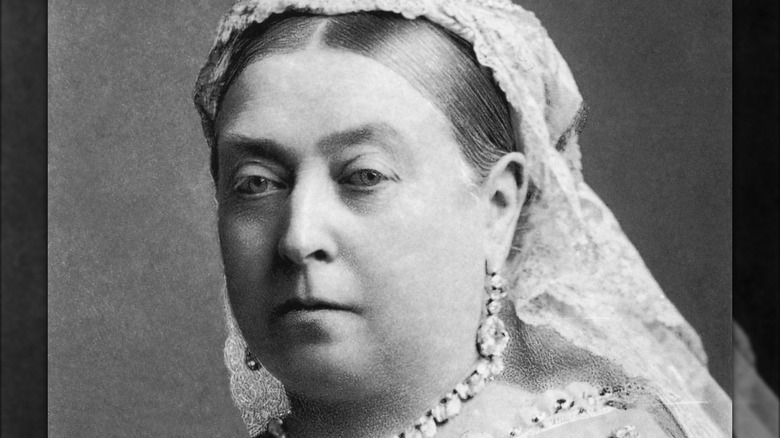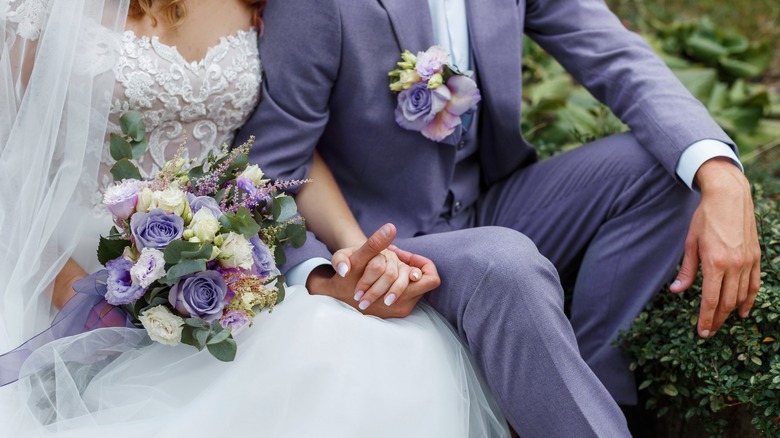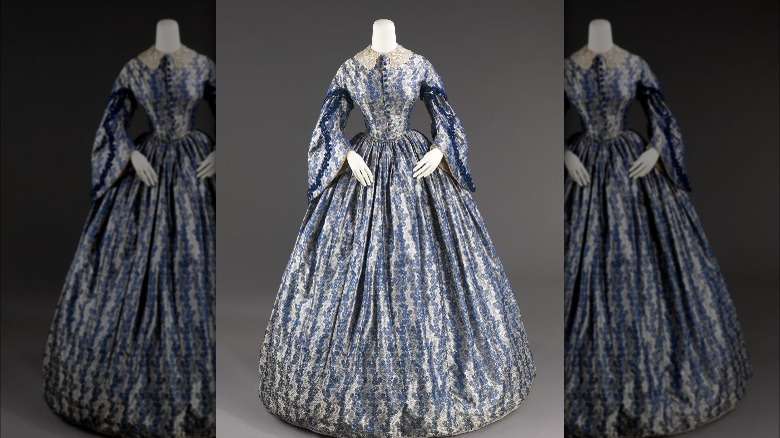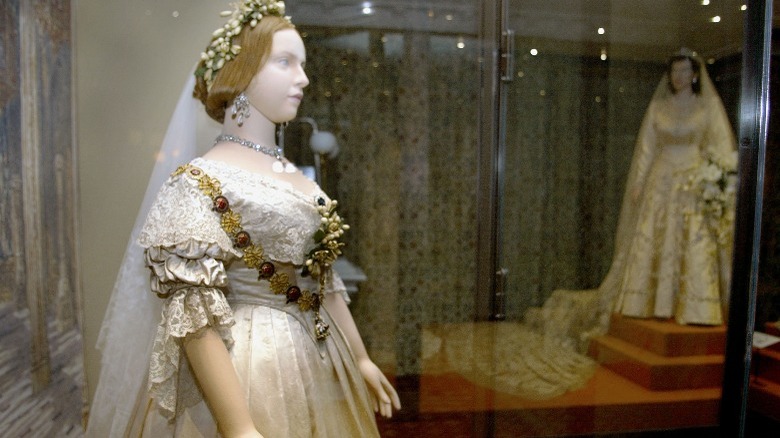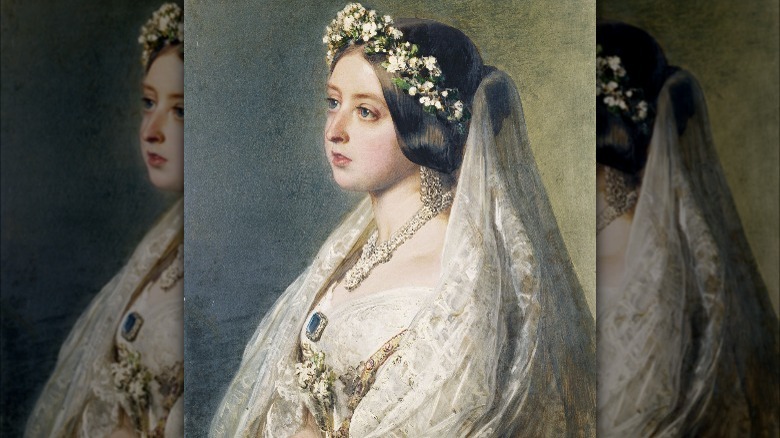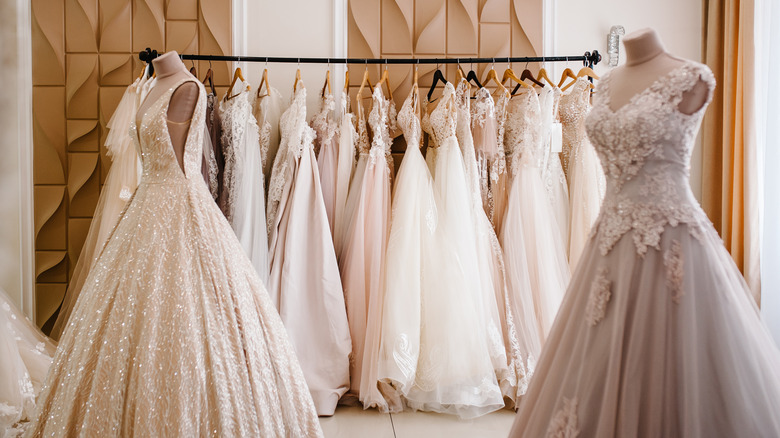This Iconic Wedding Tradition Can Be Traced All The Way Back To Queen Victoria
Some women dream of their wedding day from the time they were little girls. It's one of the most memorable events that can happen in a woman's life, and with it comes long-standing traditions. For instance, brides must have "something old, something new, something borrowed, something blue," to symbolize a long and happy marriage. As noted by Reader's Digest, the phrase dates back to Victorian times. There are also ceremonial traditions, such as the tossing of the bride's bouquet, the cutting of the cake, and the groom carrying the bride over the threshold, among other things.
When it comes to the gown, brides have a number of styles to choose from, such as a ball gown, an A-line dress, an empire line, or the trumpet gown, but despite the simplicity or complexity of the design, one thing they have in common is the color. Brides typically choose the color white or variations of ivory. The color symbolizes innocence, purity, and perfection (via Symbol Sage). However, the trend wasn't popular until the mid-19th century.
The history of weddings
The ceremony of marriage dates back many centuries. As reported by Thread Curve, marriages were celebrated with elaborate feasts during the Bronze and Iron Ages. However, the traditional wedding ceremony most likely only began during ancient times in Greece and Rome. Back then, the ceremony consisted of the father of the bride presenting his daughter to the groom with vows and a handshake. But as mentioned by The Week, unions between two people back then were not done out of love. Instead, the main purpose was to have legitimate children. In ancient Greece, the father of the bride gives away his daughter by saying, "I pledge my daughter for the purpose of producing legitimate offspring."
The ceremony was made more formal in the 1070s in Europe when marriage laws were passed and a priest blessed the bride and groom. As time passed, marriages were not only done for practical reasons, but for the sake of love as well.
Wedding dresses weren't originally white
Before white became the signature bridal dress color, brides used their best dresses to wear during the ceremony. According to Bellatory, women didn't even have special dresses made for the occasion. Instead, they just chose the best dress they had in their wardrobe, and the color didn't matter either. Dark and bold colors, such as brown, black, blue, or red were a common choice, and brides typically stayed away from white, as it was deemed a symbol of mourning.
Furthermore, the bridal dress women chose, especially for aristocrats, came embellished with jewels, gold and silver, fur, as well as other adornments that showcased their wealth. Those in the lower class wore dresses that weren't expensive but imitated the styles worn by the rich using the resources they had (via Love to Know). The type and amount of fabric used also reflected a bride's social status. Wealthy brides had gowns made of velvet or satin with long trains and voluminous sleeves, while lower-class brides opted for wool or cotton dresses.
Queen Victoria's white wedding dress
Queen Victoria wasn't the first royal to wear a white wedding dress, but the tradition started with her. According to The Conversation, instead of wearing her coronation robes to her wedding, she opted to wear a white gown (pictured above). Her wedding to Prince Albert took place in 1840, and she wore a structured white dress with lace trimmings that had a satin train that was about 18 feet long (via Fashion History Timeline). She wrote about her dress, saying, "I wore a white satin gown with a very deep flounce of Honiton lace, imitation of old. I wore my Turkish diamond necklace and earrings, and Albert's beautiful sapphire brooch."
In exchange for her crown, Queen Victoria wore a wreath of myrtle and orange blossoms on her head. She chose to forego wearing her crown and royal robes, as she stated she wanted to be married as Prince Albert's wife and not a monarch. Unlike other royal unions, their marriage occurred out of love. She had other reasons as well. As noted by CNN, the Honiton lace was handmade in Beer, a village in England, and the other materials were also British-made. This was intentional, as she wanted to support the declining industries. As for the color white, she chose it, as it was the best color that highlighted the intricate workmanship of the lace.
Her gown was featured in publications around the world
Newspapers and magazines around the world featured Queen Victoria's unique choice of wedding dress. At that time, as noted by the Victoria and Albert Museum, publications reported on high society unions as well as fashion, and the public caught a glimpse of the queen's white gown via paintings and illustrations. Brides aspired to look like the queen, and the tradition of wearing white caught on. Initially, however, white was mostly worn by the wealthy, as the color was difficult to maintain and darker colors were more ideal to hide stains.
Queen Victoria also reused her lace veil. According to Vanity Fair, it was the same one she wore for her diamond jubilee portrait, and she wore her veil and lace flounce when her children were christened. More than a decade after their marriage, Queen Victoria and Prince Albert reportedly wore their wedding attires to be photographed. After a few decades, wearing a white wedding dress became a tradition, as fabric became cheaper and easier to produce. Even lower-class citizens were able to afford white wedding dresses.
Is it an old-fashioned tradition?
Traditional brides still follow the custom of wearing white on their wedding day, but there are some who choose to be married in more colorful gowns. In a survey of 2,000 people, as reported by SWNS Digital, one in five said that the tradition of wearing a white gown is outdated. Many couples also choose to forego classic wedding traditions and make the ceremony fit their own styles and tastes. Brides also conducted a survey in 2021 wherein they asked 1,000 people planning to be married about their wedding choices, and 28% said that they won't be wearing the traditional wedding dress.
Heather McReynolds, the vice president for formalwear company David's Bridal, said that one of the most popular colors for brides who don't want a white gown is pink, while others who want a more dramatic effect opt for black, per The New York Times. Still, the majority of brides choose to wear classic white, and with the countless styles and cuts available, they can stand out and showcase their own sense of style while still sticking to the age-old tradition that Queen Victoria popularized.
